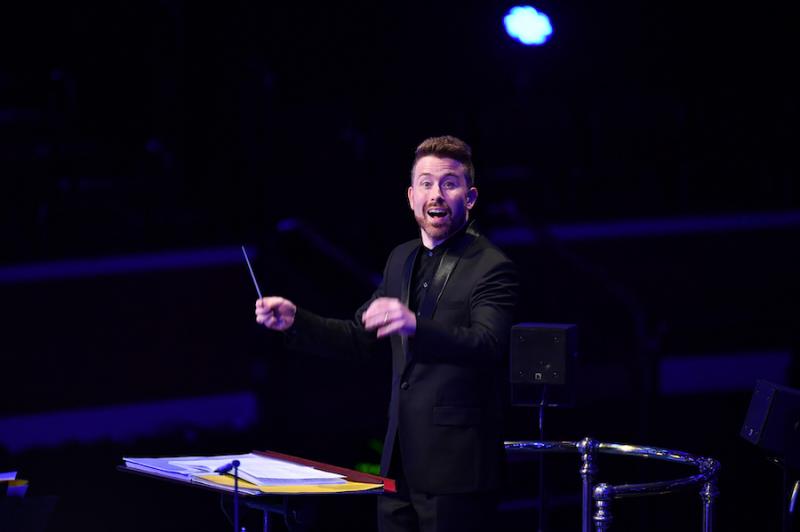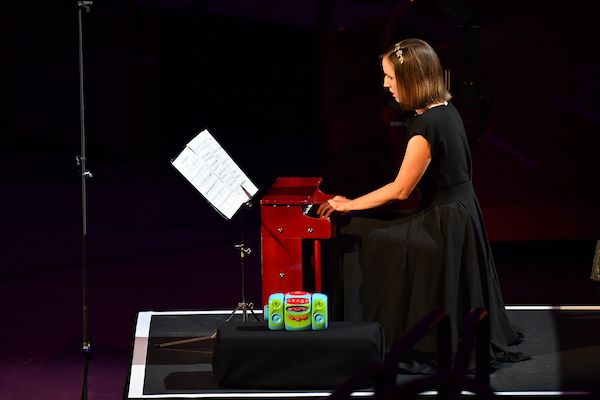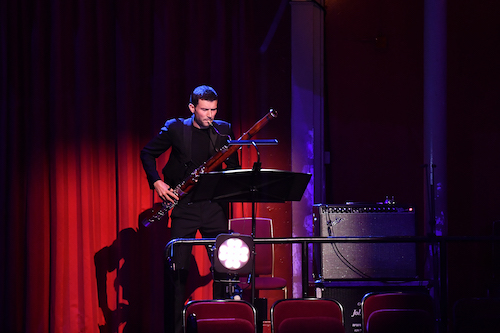BBC Proms live online: London Sinfonietta, Paterson review – varied perspectives on city life | reviews, news & interviews
BBC Proms live online: London Sinfonietta, Paterson review – varied perspectives on city life
BBC Proms live online: London Sinfonietta, Paterson review – varied perspectives on city life
A well-conceived programme allows a range of musical voices to speak

In reviewing Sunday night’s LSO Prom I was impressed by the innovative and exciting programming and that was also a hallmark of Tuesday’s Prom, although this was more true to form for the London Sinfonietta.
The most pulsing – if not pulsating – piece was Philip Glass’s Façades and actually the regular flow in the strings took a few moments to settle. After that this flat bedrock provided the perfect blank backdrop for a pair of soprano saxophones. Façades has long been a favourite backing track of documentary makers and it is clear why: although you can find it on many a “chillout classics” playlist it actually has a distinctly unrestful, haunting quality. The sax melodies – mostly plain scales – were played hypnotically by Simon Haram and Amy Green and the piece doesn’t outstay its welcome, not always the case with Glass.
One of the strengths of this programme was the bold juxtapositions between pieces, and the uneasy tread of the Glass gave way to Julia Wolfe’s East Broadway, in which Clíodna Shanahan (pictured below by Chris Christodoulou) beat the hell out of a toy piano for four minutes, accompanied by audio playback on a cheap and gaudy boombox set up by the keyboard. Looking very much like Schroeder from Peanuts, Shanahan was committed and virtuosic, right up to the final brutal forearm smashes. Conlon Nancarrow spent his life in Mexico City, hand-punching holes into piano rolls, as the only way his polymetric complexities could be realised in the mid-20th century. Some of his works were later arranged for live players by Yvar Mikhashoff, and here we heard Studies no. 6 and 9. It is rare that music this uncompromising in conception is so immediately appealing, and the insouciance of the music, with various rhythmic strands proceeding in their own time, as if oblivious to each other, is enchanting, if incredibly difficult to play. Like the music of Ligeti (who was a big fan of Nancarrow) there is the feeling of a musical vehicle constantly on the verge of lurching out of control, but never quite doing so. Glued together by bassist Enno Senft’s walking lines, this witty but generous spirited performance was a delight.
Conlon Nancarrow spent his life in Mexico City, hand-punching holes into piano rolls, as the only way his polymetric complexities could be realised in the mid-20th century. Some of his works were later arranged for live players by Yvar Mikhashoff, and here we heard Studies no. 6 and 9. It is rare that music this uncompromising in conception is so immediately appealing, and the insouciance of the music, with various rhythmic strands proceeding in their own time, as if oblivious to each other, is enchanting, if incredibly difficult to play. Like the music of Ligeti (who was a big fan of Nancarrow) there is the feeling of a musical vehicle constantly on the verge of lurching out of control, but never quite doing so. Glued together by bassist Enno Senft’s walking lines, this witty but generous spirited performance was a delight.
Tansy Davies’ neon alternated sections that she has described as a “pounding grinding groove” with more spacious elements in between. It often sounded like the bastard child of Nancarrow and Stevie Wonder but with a more acerbic, punky aesthetic. Timothy Lines (bass clarinet) was worked hard and there was noisy percussion from a selection of boxes and tin cans; the promised groove did indeed groove.
This led to the quieter contemplation of Edmund Finnis’s in situ, which with the Davies piece proves that the Sinfonietta remains a home to the lower-case title. His music was more contemplative, allusive, reflecting music by Josquin and Rameau among others in a contemporary mirror. The music was subtly scored and had a refreshing gentleness after the brittle Davies. Which cannot be said of Anna Meredith’s extraordinary Axeman. This is a bruising, scorching four minutes of rock guitar heroics, all wailing and grimy feedback – with the catch being that it is performed by that most sedate of instruments, the bassoon. The brilliant Jonathan Davies (pictured above), wired up to a distortion pedal and then fed through a guitar amp, produced the most extraordinary range of sounds and an exhilarating turning-on-its-head of musical expectations.
Which cannot be said of Anna Meredith’s extraordinary Axeman. This is a bruising, scorching four minutes of rock guitar heroics, all wailing and grimy feedback – with the catch being that it is performed by that most sedate of instruments, the bassoon. The brilliant Jonathan Davies (pictured above), wired up to a distortion pedal and then fed through a guitar amp, produced the most extraordinary range of sounds and an exhilarating turning-on-its-head of musical expectations.
The finale actually felt a bit flat after that one. Steve Reich’s City Life is his mid-1990s tribute to his home city of New York, combining the live ensemble with field recordings of the city that he made himself. Spoken phrases are then picked out instrumentally in a device he created in the brilliant Different Trains (1988). But in City Life the recordings somehow don’t feel as integrated, sitting more on the surface and even getting in the way of the music. The exceptions are the third movement where a sample prompts an agglomerating process which unfolds with the singlemindedness of early Reich, and the fourth, exploring the “heartbeat of the city” literally through a heartbeat sample. Geoffrey Paterson kept a benevolent hand on the tiller here as throughout – conducting minimalist music can be a bit thankless – and Ian Dearden’s sound projections came over well on the livestream, although I suspect he may have been the one person involved relieved there wasn’t an audience, as pleasing everyone in the hall is beyond any sound engineer.
- Watch the livestream of this concert on BBC iPlayer or listen on BBC Radio 3 for the next month
- More classical reviews on theartsdesk
rating
Explore topics
Share this article
The future of Arts Journalism
You can stop theartsdesk.com closing!
We urgently need financing to survive. Our fundraising drive has thus far raised £49,000 but we need to reach £100,000 or we will be forced to close. Please contribute here: https://gofund.me/c3f6033d
And if you can forward this information to anyone who might assist, we’d be grateful.

Subscribe to theartsdesk.com
Thank you for continuing to read our work on theartsdesk.com. For unlimited access to every article in its entirety, including our archive of more than 15,000 pieces, we're asking for £5 per month or £40 per year. We feel it's a very good deal, and hope you do too.
To take a subscription now simply click here.
And if you're looking for that extra gift for a friend or family member, why not treat them to a theartsdesk.com gift subscription?
more Classical music
 Bizet in 150th anniversary year: rich and rare French offerings from Palazzetto Bru Zane
Specialists in French romantic music unveil a treasure trove both live and on disc
Bizet in 150th anniversary year: rich and rare French offerings from Palazzetto Bru Zane
Specialists in French romantic music unveil a treasure trove both live and on disc
 Scottish Chamber Orchestra, Ibragimova, Queen’s Hall, Edinburgh review - rarities, novelties and drumrolls
A pity the SCO didn't pick a better showcase for a shining guest artist
Scottish Chamber Orchestra, Ibragimova, Queen’s Hall, Edinburgh review - rarities, novelties and drumrolls
A pity the SCO didn't pick a better showcase for a shining guest artist
 Kilsby, Parkes, Sinfonia of London, Wilson, Barbican review - string things zing and sing in expert hands
British masterpieces for strings plus other-worldly tenor and horn - and a muscular rarity
Kilsby, Parkes, Sinfonia of London, Wilson, Barbican review - string things zing and sing in expert hands
British masterpieces for strings plus other-worldly tenor and horn - and a muscular rarity
 From Historical to Hip-Hop, Classically Black Music Festival, Kings Place review - a cluster of impressive stars for the future
From quasi-Mozartian elegance to the gritty humour of a kitchen inspection
From Historical to Hip-Hop, Classically Black Music Festival, Kings Place review - a cluster of impressive stars for the future
From quasi-Mozartian elegance to the gritty humour of a kitchen inspection
 Shibe, LSO, Adès, Barbican review - gaudy and glorious new music alongside serene Sibelius
Adès’s passion makes persuasive case for the music he loves, both new and old
Shibe, LSO, Adès, Barbican review - gaudy and glorious new music alongside serene Sibelius
Adès’s passion makes persuasive case for the music he loves, both new and old
 Anja Mittermüller, Richard Fu, Wigmore Hall review - a glorious hall debut
The Austrian mezzo shines - at the age of 22
Anja Mittermüller, Richard Fu, Wigmore Hall review - a glorious hall debut
The Austrian mezzo shines - at the age of 22
 First Person: clarinettist Oliver Pashley on the new horizons of The Hermes Experiment's latest album
Compositions by members of this unusual quartet feature for the first time
First Person: clarinettist Oliver Pashley on the new horizons of The Hermes Experiment's latest album
Compositions by members of this unusual quartet feature for the first time
 Gesualdo Passione, Les Arts Florissants, Amala Dior Company, Barbican review - inspired collaboration excavates the music's humanity
At times it was like watching an anarchic religious procession
Gesualdo Passione, Les Arts Florissants, Amala Dior Company, Barbican review - inspired collaboration excavates the music's humanity
At times it was like watching an anarchic religious procession
 Classical CDs: Camels, concrete and cabaret
An influential American composer's 90th birthday box, plus British piano concertos and a father-and-son duo
Classical CDs: Camels, concrete and cabaret
An influential American composer's 90th birthday box, plus British piano concertos and a father-and-son duo
 Cockerham, Manchester Camerata, Sheen, Martin Harris Centre, Manchester review - re-enacting the dawn of modernism
Two UK premieres added to three miniatures from a seminal event of January 1914
Cockerham, Manchester Camerata, Sheen, Martin Harris Centre, Manchester review - re-enacting the dawn of modernism
Two UK premieres added to three miniatures from a seminal event of January 1914
 Kempf, Brno Philharmonic, Davies, Bridgewater Hall, Manchester review - European tradition meets American jazz
Bouncing Czechs enjoy their Gershwin and Brubeck alongside Janáček and Dvořák
Kempf, Brno Philharmonic, Davies, Bridgewater Hall, Manchester review - European tradition meets American jazz
Bouncing Czechs enjoy their Gershwin and Brubeck alongside Janáček and Dvořák
 Solomon, OAE, Butt, QEH review - daft Biblical whitewashing with great choruses
Even a top soprano and mezzo can’t make this Handel paean wholly convincing
Solomon, OAE, Butt, QEH review - daft Biblical whitewashing with great choruses
Even a top soprano and mezzo can’t make this Handel paean wholly convincing

Add comment